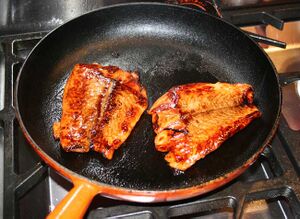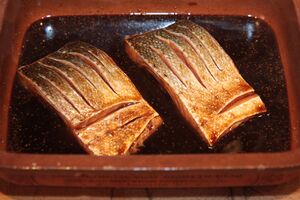Salmon: Difference between revisions
mNo edit summary |
No edit summary |
||
| (3 intermediate revisions by 2 users not shown) | |||
| Line 3: | Line 3: | ||
|title=Salmon: Cooking Wiki | |title=Salmon: Cooking Wiki | ||
|titlemode=replace | |titlemode=replace | ||
|keywords= | |keywords=#salmon #clareislandsalmon #trout #scottishfarmedsalmon #refrigeration #fishandseafood #tuna #descale #hotorcoldsmoked | ||
|hashtagrev=12032020 | |||
|description=Salmon is the common name for several species of Fish of the family Salmonidae. Several other fish in the family are called trout | |description=Salmon is the common name for several species of Fish of the family Salmonidae. Several other fish in the family are called trout | ||
}} | }} | ||
<!-- /seo --> | <!-- /seo --> | ||
'''Salmon''' is the common name for several species of Fish of the family Salmonidae. Several other fish in the family are called [[trout]]. Salmon live in both the Atlantic and Pacific Oceans, as well as the Great Lakes and other land locked lakes. | '''Salmon''' is the common name for several species of Fish of the family Salmonidae. Several other fish in the family are called [[trout]]. Salmon live in both the Atlantic and Pacific Oceans, as well as the Great Lakes and other land locked lakes. | ||
Salmon flesh is generally orange to red in colour, although there are some examples of white fleshed wild salmon. The natural colour of salmon results from carotenoid pigments, largely astaxanthin (E161j), in the flesh. Wild salmon get these carotenoids from eating krill and other tiny shellfish. Because consumers have shown a reluctance to purchase white fleshed salmon, astaxanthin, and very minutely canthaxanthin (E161g)), are added as artificial colourants to the feed of farmed salmon because prepared diets do not naturally contain these pigments. | Salmon flesh is generally orange to red in colour, although there are some examples of white fleshed wild salmon. The natural colour of salmon results from carotenoid pigments, largely astaxanthin (E161j), in the flesh. Wild salmon get these carotenoids from eating krill and other tiny shellfish. Because consumers have shown a reluctance to purchase white fleshed salmon, astaxanthin, and very minutely canthaxanthin (E161g)), are added as artificial colourants to the feed of farmed salmon because prepared diets do not naturally contain these pigments. | ||
<gallery widths=300px heights=300px perrow=5> | |||
Image:Pan-seared salmon fillets.jpg|thumb|right|300px|Pan-seared salmon, cooked and ready to rest | |||
Image:Slash after descaling.jpg|thumb|right|300px|Slash the skin after descaling so marinade is absorbed both sides evenly | |||
Image:Atlantic salmon.jpg|thumb|right|300px|Atlantic salmon | |||
</gallery> | |||
Raw salmon flesh may contain Anisakis nematodes, marine parasites that cause Anisakiasis. Before the availability of [[refrigeration]], the Japanese did not consume raw salmon. Salmon and salmon roe have only recently come into use in making sashimi (raw fish) and sushi. | Raw salmon flesh may contain Anisakis nematodes, marine parasites that cause Anisakiasis. Before the availability of [[refrigeration]], the Japanese did not consume raw salmon. Salmon and salmon roe have only recently come into use in making sashimi (raw fish) and sushi. | ||
| Line 28: | Line 28: | ||
A salmon steak where the meat is cut down to the backbone resulting in a thick steak, as pictured in the marinade above. | A salmon steak where the meat is cut down to the backbone resulting in a thick steak, as pictured in the marinade above. | ||
{{SeasonalInfoIs}} | {{SeasonalInfoIs}} | ||
February, March, April, May, June, July, August & September. | February, March, April, May, June, July, August & September. | ||
==See also== | |||
* [[Clare Island salmon]] | |||
* [[Scottish farmed salmon]] | |||
{{CategoryLineIngredients}} | {{CategoryLineIngredients}} | ||
[[Category:Ingredients]] | [[Category:Ingredients]] | ||
[[Category:Fish and seafood]] | [[Category:Fish and seafood]] | ||
[[ | |||
<!-- footer hashtags --><code 'hashtagrev:12032020'>[[Special:Search/salmon|#salmon]] [[Special:Search/clareislandsalmon|#clareislandsalmon]] [[Special:Search/trout|#trout]] [[Special:Search/scottishfarmedsalmon|#scottishfarmedsalmon]] [[Special:Search/refrigeration|#refrigeration]] [[Special:Search/fishandseafood|#fishandseafood]] [[Special:Search/tuna|#tuna]] [[Special:Search/descale|#descale]] [[Special:Search/hotorcoldsmoked|#hotorcoldsmoked]] | |||
</code><!-- /footer hashtags --> | |||
Latest revision as of 10:34, 23 September 2024
Salmon is the common name for several species of Fish of the family Salmonidae. Several other fish in the family are called trout. Salmon live in both the Atlantic and Pacific Oceans, as well as the Great Lakes and other land locked lakes.
Salmon flesh is generally orange to red in colour, although there are some examples of white fleshed wild salmon. The natural colour of salmon results from carotenoid pigments, largely astaxanthin (E161j), in the flesh. Wild salmon get these carotenoids from eating krill and other tiny shellfish. Because consumers have shown a reluctance to purchase white fleshed salmon, astaxanthin, and very minutely canthaxanthin (E161g)), are added as artificial colourants to the feed of farmed salmon because prepared diets do not naturally contain these pigments.
-
Pan-seared salmon, cooked and ready to rest
-
Slash the skin after descaling so marinade is absorbed both sides evenly
-
Atlantic salmon
Raw salmon flesh may contain Anisakis nematodes, marine parasites that cause Anisakiasis. Before the availability of refrigeration, the Japanese did not consume raw salmon. Salmon and salmon roe have only recently come into use in making sashimi (raw fish) and sushi.
Smoked salmon is a preparation of salmon, typically a fillet that has been cured and then hot or cold smoked. Due to its moderately high price, smoked salmon is considered a delicacy.
As with tuna, when cooking salmon, descale always let it rest for 5 minutes after the cooking has ended. This will result in a moist texture.
A salmon fillet is when the meat is cut parallel to the backbone resulting in a thin fillet, as pictured in the pan above.
A salmon steak where the meat is cut down to the backbone resulting in a thick steak, as pictured in the marinade above.
Seasonal Information: Salmon
This information is specifically for countries in the northern temperate zone of the Northern Hemisphere; particularly the United Kingdom, however it should be applicable for northern USA, northern Europe, Canada, Russia, etc.
Salmon is at its best and in season during the following months: February, March, April, May, June, July, August & September.
See also
Find recipes that contain 'Salmon'
#salmon #clareislandsalmon #trout #scottishfarmedsalmon #refrigeration #fishandseafood #tuna #descale #hotorcoldsmoked


